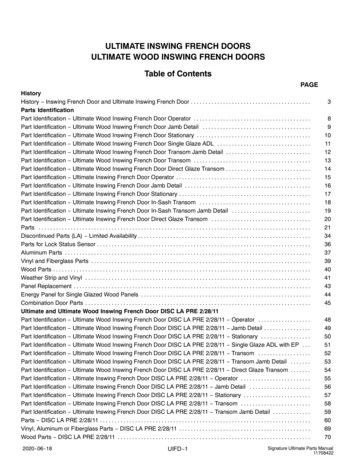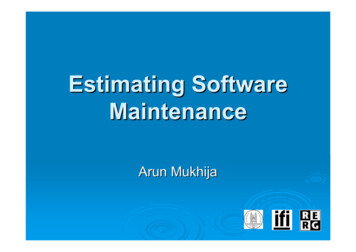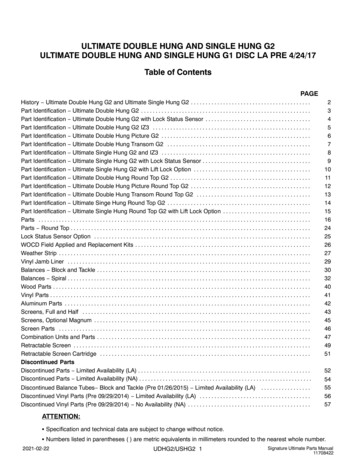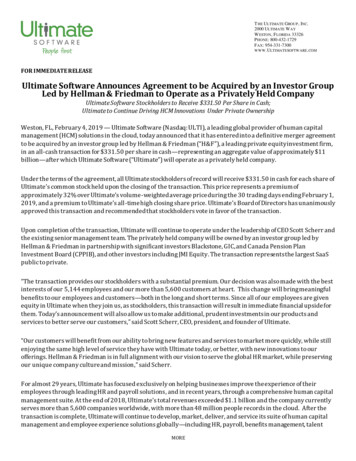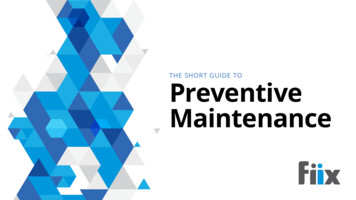
Transcription
The Ultimate Guideto MaintenanceMetrics and KPIs The Ultimate Guide to Maintenance Metrics and KPIs1
Table of ContentsIntroduction3Terminology4What Is a Metric?4What Is a KPI?4What Is the Difference Between Metrics and KPIs?4What Are Leading and Lagging Indicators?45 Considerations for Choosing Metrics to Track6What Are Your Organization’s Goals?6What Are You Already Tracking?6What Type of Assets Are You Tracking?7How Critical Is the Asset?7Cause and Effect Relationships7Types of Maintenance Metrics8Equipment Downtime8Maintenance Backlog9Mean Time Between Failure (MTBF)10Mean Time to Repair (MTTR)11Overall Equipment Effectiveness (OEE)13Planned Maintenance Percentage (PMP)15Schedule Compliance15Other Important Maintenance Metrics17Formula Guide17Conclusion18Learn More18 The Ultimate Guide to Maintenance Metrics and KPIs2
IntroductionMost organizations are aware of how important it is to use data intheir decision making. Maintenance teams are no different. If youhave the right data, you’ll be able to make more sensible decisions.The challenge comes in choosing which metrics to track.Choosing the right metrics helps you prioritize the right tasks andalign your goals with those of other departments. Therefore, trackingmaintenance metrics is a vital component of achieving world-classmaintenance in your organization.When you select the best key performance indicators (KPIs) foryour organization, you can find ways to reduce downtime and boostrevenue. By limiting yourself to only the most important KPIs, you aimfor world-class performance.This is UpKeep’s guide to the key metrics and KPIs that arecritical for any facility to identify. We’ll discuss overviews, formulas,strategies, and tips for pinning down the right metrics to track foryour maintenance team. The Ultimate Guide to Maintenance Metrics and KPIs33
TerminologyWhat Is a Metric?A metric is any number your organizationmight track. Each metric has its uses, andsome may be more useful for markingprogress than others, but all of them shouldgive you some insight into what goes on inyour processes.For example, preventive maintenanceschedule compliance may not tell you muchabout the company’s profitability as a whole,but it does provide insight into how yourmaintenance processes are going.What Is a KPI?A key performance indicator (KPI), on theother hand, is a metric that providesinsight into your organization’s performanceas a whole. Ideally, they’re linked withbusiness goals.For instance, a manufacturer striving for topcustomer satisfaction will likely use customerrejects and satisfaction as key performanceindicators. However, planned maintenancepercentage and other maintenance metricswill likely be less useful here.What Is the DifferenceBetween Metrics and KPIs?Metrics and KPIs are similar, as they bothmeasure your company’s performanceagainst particular goals. Both look at currentperformance or measures, establish ideallevels for the future, and work toward thosegoals. The major difference is that metrics area measurement of progress toward a goal;KPIs are target numbers to hit.What Are Leading andLagging Indicators?Metrics and KPIs are generally classifiedaccording to whether they predict futureperformance or describe past performance.These are referred to as leading or laggingindicators, respectively.Leading IndicatorsLeading indicators are measurements thatpredict the outcome of a process or anevent. These indicators are measured andare considered to be precursors of events orsituations.An example of a leading indicator isschedule compliance, when regarded asan indicator of the likelihood that an assetwill experience unplanned failures anddowntime. Because schedule compliancedescribes the amount of plannedmaintenance activities done on time, itcan be correlated with how effectivelymaintenance activities are carried out, andtherefore relate to increasing reliability. The Ultimate Guide to Maintenance Metrics and KPIs4
TerminologyLeading KPIs lead to results;lagging KPIs are the results. If youare managing maintenance withoutaccurate leading and lagging KPIs,then you are lost.”- Ricky Smith, Vice President,World Class MaintenanceSimilarly, the metric planned maintenancepercentage can be considered a leadingindicator as it affects the amount ofunplanned downtime by aiming to keepassets running at optimal health. It alsoaffects the required manpower as plannedmaintenance activities can be moreefficiently scheduled.Lagging IndicatorsLagging indicators measure theperformance of the plant by looking at theoutcomes and results of processes andoperations. By analyzing the historical trendof the performance of the plant and itsparts, reactive strategies can be applied toaddress underlying issues.Examples of lagging indicators include meantime to repair (MTTR), mean time betweenfailure (MTBF), and overall equipmenteffectiveness (OEE). Notice how thesemetrics are measured to confirm trends thathave developed over time. Because thesemetrics are basically a historical record ofperformance, they can provide insights onwhich events in the past might have causedfluctuations to the plant’s performance. The Ultimate Guide to Maintenance Metrics and KPIs5
5 Considerations forChoosing Metrics to TrackWhen it comes to maintenance planning,you will likely focus on both lagging andleading indicators—the former to showyour progress, and the latter to manageroot causes. But as explained, choosingthe right ones to track can be a challenge.How do you know what’s worth tracking?These considerations may help in thedecision-making process.1What Are YourOrganization’s Goals?For starters, consider your goals. Thesecan be any goals from your organization.For example, if your goal is to increaseproduction, you’ll need some metricsaround maintenance to ensure that you’rehitting your availability targets.Of course, at lower levels, yourgoals would get more specific. In amanufacturing plant, for instance, youmight have a goal to increase yourconveyor system’s uptime by a certainpercentage. With that goal in mind,you’ll be able to start looking at whichleading indicators would support that.Make a list of possibilities to get started.Your list might include your preventivemaintenance (as a percentage of totalmaintenance), your schedule compliancefor the preventive maintenance, and yourmaintenance backlog.2What Are You AlreadyTracking?When you have an idea of which indicatorsmight help you meet your overall goals,determine what you’re already tracking andstart there. For some metrics, you’ll needsome time to get enough data to makeit truly meaningful. As such, using thosewouldn’t be as economical as pulling fromexisting data.In our conveyor system example, if you’realready tracking preventive maintenancebut not other metrics, start with that one. Ifyou’re not tracking schedule compliance orwork order backlogs, you can’t use thoseuntil you do, and getting that data togetherwould take extra time.At the end of the day, it’s a return oninvestment calculation. What’s the benefitand cost of tracking the metric? If thatratio is large enough (or at a minimum,the benefit outweighs the cost), then youshould consider tracking it. But be carefulwith over-tracking metrics. Many companiestrack metrics but never use them foranything. Ask yourself these questions:What are you planning to use this for?What actions are you going to drive?What does this help you understandabout your business? The Ultimate Guide to Maintenance Metrics and KPIs6
5 Considerations for Choosing Metrics to Track3What Type of AssetsAre You Tracking?The matter of which type of assets you’retracking is another important consideration.Different assets have different needs andpurposes, and what would make sense forone might not be right for another.For example, if you’re tracking amission-critical mixer, you’ll likely want tofocus on preventive maintenance, meantime to repair, and other such metrics. Forsomething less important like lightbulbs inthe men’s bathroom, you’re probably nottoo interested in the time it takes to replacethose. Instead, measurements such asstockouts or other inventory metrics would bemore relevant.4How Critical Isthe Asset?Criticality, of course, should always enter intoyour decisions on what metrics to track. Anon-critical piece of equipment wouldn’t beas important to track as one that’s core toyour process.If an asset is at high risk of failure, and if thatfailure would have a significant impact on yourprocess, you’ll want to track it more carefullyby monitoring leading indicators. For anasset that’s less likely to fail and that wouldn’tcause a significant disruption if it wentdown, surface-level monitoring with laggingindicators might be more appropriate.Risk is also important. If it’s low-criticalequipment, but it fails multiple times daily,the risk is very high. Small, chronic failuresare a big issue in manufacturing.5Cause and EffectRelationshipsThe last consideration is a matter of causeand effect. When choosing leading indicators,you’ll need to determine whether they trulyhave an impact on your desired results. Afterall, metrics are only of any value if they arepredictive in nature.Often, finding whether a given metric is trulypredictive of future success is a matter of trialand error. You start tracking the data, andthen see if lagging indicators correlate with it.Existing studies can also help you pin downcause and effect relationships. Back to ourconveyor system example, studies show thatpreventive maintenance provides 12% to18% cost savings over reactive maintenance,meaning there’s a good chance that trackingand improving preventive maintenanceas a metric would help reduce unplanneddowntime.Maintenance metrics and KPIs to our organization aren’t just a tool to evaluateour technician teams; they set the benchmark in which we build and modifyprocesses, plan future decisions, and improve our operations upon. KPIs are adirect look into the important details and trends that are sometimes hidden bythe day-to-day rhythm.”-Joe Faloon, Vice President, Springfield Pepsi-Cola The Ultimate Guide to Maintenance Metrics and KPIs7
Types ofMaintenance MetricsNot every maintenance metric is of equalimportance to every company. Metricsthat qualify as KPIs are dependent on yourindustry, your company’s goals, and thetypes of assets you manage. When youselect the best metrics and KPIs for yourorganization, you can find ways to reducedowntime and boost revenue.Instead of placing equal importance onevery metric you track, choose a fewKPIs. You can also choose a few leadingindicators that help you determine whyKPIs are getting hit or being missed. Forinstance, if schedule compliance is a KPI,percentage of work covered by a work ordermay be a leading indicator.Below, we explore different maintenancemetrics that you can track as KPIs andleading indicators.EquipmentDowntimeOverviewEquipment downtime refers to the amountof time that equipment is not operating,whether that’s a result of unplannedequipment failure (like a fault or brokenpart) or planned downtime (like necessarydowntime for preventive maintenance).Typically, the term equipment downtimerefers to unexpected downtime thataccumulates any time the productionprocess stops.World-Class StandardAim for unscheduled downtime to be 10% orless, meaning that a facility’s equipment shouldbe running at 90% availability or greater.Why It’s ImportantTracking equipment downtime is particularlyimportant for a few reasons. Having a goodidea of a facility’s typical uptime works as adiagnostic tool for the facility’s maintenanceand production efforts. For example, a highequipment downtime figure might mean thatpreventive maintenance isn’t being performedproperly, or that there are problems with howproduction is set up. On the other hand, a lowmaintenance downtime figure can indicate agenerally healthy production environment. The Ultimate Guide to Maintenance Metrics and KPIs8
Types of Maintenance MetricsThis can be even more granular if equipmentdowntime is tracked on a per-area basis. Ifdowntime is especially high in the final assemblyportion of a production line, it’s clear whereimprovements need to happen. In this way,tracking downtime becomes a method of mappingout the overall health of each individual part ofan organization’s production. While it can seemexpensive to track downtime with a computerizedmaintenance management system (CMMS), there’sa potentially far larger amount of money saved onknowing where issues lie and eliminating them.How to Calculate(Hrs of downtime / total period measured) * 100Because the term equipment downtime can applyto any event that halts manufacturing, it’s importantfor an organization to first figure out what kind ofdowntime they want to calculate.MAINTENANCEBACKLOGOverviewUsually measured in work days or weeks, themaintenance backlog as a metric quantifies theamount of time required for a defined number ofworkers to complete all pending maintenancetasks. Maintenance backlog is composed ofactivities related to preventive maintenance and anyother outstanding maintenance such as requiredcorrective maintenance.It goes without saying that not all tasks in thebacklog are equally urgent. Having some backlogis not necessarily a reason to panic—it can even bean indicator of optimized staffing. The dangers ofmaintenance backlog creep in when maintenanceschedules are disrupted by emergency work and aninefficient prioritization model. The Ultimate Guide to Maintenance Metrics and KPIs9
Types of Maintenance MetricsNeglected tasks in the maintenance backlogbecome deferred maintenance, inevitablycausing more breakdowns and seriousdowntime. Breakdowns require immediateunplanned maintenance tasks that in turndisrupt scheduled activities. Disruptionsto the schedule push more tasks into thebacklog to continue the vicious cycle.World-Class StandardAim to have a maintenance backlog ofaround six weeks worth of tasks pertechnician.How Much Backlog IsToo Much?Maintenance backlog provides a list ofthings to do over a certain period of time.Having some amount of backlog is generallyacceptable. Having no backlog may beindicative of overstaffing. The idea is not toeliminate the backlog but to manage it.The exact ideal amount of backlog may varyfor each business, but the idea remains thatsome amount of pending work can be auseful metric when managed properly.The important point in measuringmaintenance backlog is defining how it’smeasured. Agree with the team and withyour stakeholders on what constitutes themaintenance backlog.How much of it is preventive maintenance,and how much of it is correctivemaintenance? Differentiate between tasksand delegate maintenance work accordingly,so that the workforce is utilized moreeffectively towards managing the backlog.MEAN TIME BETWEENFAILURE (MTBF)OverviewMean time between failure (MTBF) as amaintenance metric indicates the durationthat an equipment operates withoutdisturbances. This intuitively relates to theavailability of the equipment. Availability,also known as uptime, is one of the keyindicators of overall equipment effectivenessand is always a focus area for improvingproductivity. An equipment’s total uptimecan be expressed in terms of the MTBFtogether with another metric,the MTTR (mean time to repair).It is important to note that MTBF isapplicable only to repairable items.Manufacturing processes can use it to planfor contingencies that require the repairof key equipment. Being aware of thisdata provides insights for making sounddecisions for the plant. There’s also meantime to failure, which is for non-repairableequipment.World-Class StandardVaries based on equipment type.How to Calculate MTBFThe MTBF is calculated by taking the totaltime a piece of equipment is running (i.e.uptime) and dividing it by the number ofbreakdowns that occurred over thesame period.MTBF total uptime / # of breakdowns The Ultimate Guide to Maintenance Metrics and KPIs10
Types of Maintenance MetricsHow to Improve MTBFIncreasing the MTBF increasesthe uptime of equipment. Keepingtrack of the MTBF for each pieceof equipment, especially those thatrequire continuous operation, allowsthe maintenance team to efficientlyschedule maintenance activities.The first step to improving MTBFis to make sure that the data beingcollected is accurate. Developmentof tools such as various maintenancesoftware can ensure that data is beingrecorded correctly and accurately.The next step to gathering data isusing it to proactively performpreventive maintenance. Investing thetime to perform maintenance checksand activities such as checking forproper lubrication, aligning calibrationsystems, and cleaning pays off bysignificantly reducing the number ofmajor stoppages due to breakdowns.MEAN TIME TO REPAIR(MTTR)OverviewMean time to repair (MTTR) is the averagetime it takes for equipment to be diagnosed,repaired, and recovered after experiencinga failure. It’s a metric that is used to assessmaintenance effectiveness.One of the factors that contributes to aplant’s overall equipment effectiveness isthe availability of the equipment to performits functions. When equipment experiencesdowntime, especially due to failures, itsavailability is negatively impacted andtherefore reflects poorly on the overallproductivity of the system.By keeping a data-driven mindset andproactively improving the MTTR, themanufacturing processes can reduceavailability losses due to repairs. The idea isto speed up the equipment’s rate of recoveryfrom failures and breakdowns. Minimizing theMTTR values of equipment is a step towardsmaximizing a plant’s productivity.World-Class StandardA key and fundamental metricfor my organization is correctivework generated from preventive.This is quantified by task fail workorder generation and viewed as apercentage of overall work orders.This fundamental process keepsthe technicians engaged in failfinding at the right time duringschedule service.”Though diligence in noting reliability andavailability data has improved over the years,the method of measuring metrics such asMTTR has no clear industry standard.Keeping in mind potential inconsistencies inrecording data, it’s important to always definethe methodology by which variables withinthe operations are measured. This providesa transparent guide for internal teams andexternal stakeholders alike.- Bryan Bieschke, Director,Maintenance & Reliability, T. Parker Host The Ultimate Guide to Maintenance Metrics and KPIs11
Types of Maintenance MetricsHow to Calculate MTTRThe MTTR is equal to the average duration of each stoppage due to failure. This iscalculated by taking the total downtime that goes into the repair and recovery ofequipment, divided by the number of times that the same equipment has stoppedits operations.MTTR can be written in the form of the formula:MTTR total downtime / # occurrences of stoppagesNote that the MTTR formula in itself is not dependent on the span of time in whichthe equipment operates (i.e. uptime). MTTR is only quantified by the average timeeach stoppage lasts, regardless of the period between the instances of downtime.How to Improve MTTRThe most effective way to reduce MTTRis to get to the root cause of the failurebefore it even occurs. Closely monitoringoperational data of each piece ofequipment in the plant enables the earlydetection of possible causes of failure.In today’s setting, these tasks can becompleted more easily and accuratelywith tools such as CMMS software.The MTTR formula initself is not dependent onthe span of time in which theequipment operates (i.e. uptime).MTTR is only quantified by theaverage time each stoppagelasts, regardless of the periodbetween the instances ofdowntime.Performing preventive maintenance onequipment addresses most issues thateventually lead to major breakdowns.When equipment is routinely scheduledfor inspection and maintenance work,points of failure are identified early, andthe resulting MTTR is relatively short.Another way to improve MTTR andincrease availability is to map out andplan ahead for possible breakdownscenarios. Anticipation of possiblebreakdown causes can better equip theteam with efficient solutions to quicklyresolve issues. The Ultimate Guide to Maintenance Metrics and KPIs12
Types of Maintenance MetricsOVERALL EQUIPMENTEFFECTIVENESS (OEE)How to Calculate OEETo calculate OEE, three main factors needto be defined and quantified:OverviewOverall equipment effectiveness (OEE)is a standard used for measuring plantperformance. Calculating a plant’s OEEhelps identify areas that are holding theplant back from performing atmaximum capacity.World-Class StandardThree main factors drive a plant’sperformance: availability, performanceefficiency, and rate of quality products.Seiichi Nakajima, who conceptualized andintroduced OEE, provides ideal scores foreach of these factors to achievea world-class OEE rating:Availability 90%Performanceefficiency 95%Rate of qualityproducts 99%Aim to have an OEE of 77% or greater.1. AvailabilityAvailability quantifies the amount of time thatequipment is able to perform its function. It’scalculated as the ratio of the actual operationtime to the available time per day, where theavailable time per day is equated to a fullworking shift.Availability (available time planned downtime) / available time2. Performance EfficiencyPerformance efficiency quantifies how muchlonger it takes to complete a process comparedto its ideal cycle time.A simplified calculation is taken by multiplyingthe number of processed units by the ideal cycletime, then dividing the product by the actualoperation time.Performance efficiency [(# processed units * ideal cycletime) / actual operation time]3. Rate of Quality ProductsRate of quality products quantifies how much ofthe total produced units are within the acceptablestandards of good quality.For a batch of 440 units produced with only 435units of acceptable quality, the rate of qualityproducts is calculated to be 97.73%.Rate of quality products (# units ofacceptable quality / # units produced)4. Overall Equipment EffectivenessThe OEE is then calculated by taking the productof its three main factors.OEE availability * performance efficiency* rate of quality products The Ultimate Guide to Maintenance Metrics and KPIs13
Types of Maintenance MetricsHow to Improve OEEBeing aware of the factors contributing to the OEE allows for proper planning toproactively reduce process inefficiencies and losses. Clearly, improving one or all of thefactors will in turn improve the OEE of the plant.A good start to boost the plant’s effectiveness is to eliminate the “six big losses” thatevery manufacturing unit should be aware of.Each of these six points directly impact at least one of the factors that constitutes theoverall effectiveness. Addressing these losses will inevitably lead to an improved OEE.Avoid Equipment FailureRefers to mechanical breakdowns of key equipment, or generally anyunplanned downtime that can cause a significant decrease in availabilityExpedite Setup and AdjustmentA period of reduced or stopped activity (usually planned) when equipment isbeing set up and adjusted (e.g. system preparations, warmup, maintenance)Minimize Idling and Minor StoppagesMinor interruptions in production that can cause unnecessary increases tothe production timeTroubleshoot Reduced SpeedOccurs when equipment is running at increased cycle times that vary toomuch from ideal levelsMinimize Defects in ProcessAny errors along the processing flow that add flaws to the finished product,and therefore a decrease in the number of quality productsPrevent Reduced YieldOccurs when equipment is not working under the optimal conditionsto produce products within the acceptable quality standards (e.g. unitsproduced while the equipment has just started running or is being set up) The Ultimate Guide to Maintenance Metrics and KPIs14
Types of Maintenance MetricsPLANNED MAINTENANCEPERCENTAGE (PMP)SCHEDULECOMPLIANCEOverviewOverviewPlanned maintenance percentage (PMP) isa percentage that describes the amount ofmaintenance time used towards plannedmaintenance tasks, which is measured againstthe total amount of maintenance hours in agiven time period (weeks, months, years).Organizations that are committed tomeasuring the effectiveness of theirscheduled maintenance process useschedule compliance as a performancemetric. Maintenance activities are typicallyscheduled over the course of one week,and schedule compliance is measured overthe same period, although time periodsmay vary by organization. It’s critical thatmanagers create a formal process thatpromotes periodic review of results andopen discussion for areas of improvement.The PMP metric exists because it’s useful fororganizations to track how their maintenancetime is spent. While a planned maintenancepercentage shows an organization howmuch time is spent performing plannedmaintenance, it also shows how much timeis spent fixing reactive/corrective issues andunplanned downtime events.Calculating a facility’s PMP is a useful wayof determining what issues need to becombated. For example, if the PMP is low(which means a small amount of maintenancehours is being spent on planned maintenance),there could be a problem with productionequipment that’s keeping it from functioningat an appropriate level. In this way, PMP isnot only a measurement tool for plannedmaintenance efficiency but also adiagnostic tool.World-Class StandardAim to have a planned maintenancepercentage of 85%.How to Calculate PMPYou can calculate PMP with thefollowing equation:Manufacturing organizations benefit themost from tracking schedule compliancewhen properly implemented. Bydefinition, the organization is requiredto proactively create a work scheduleto adhere to. In manufacturing plants,scheduled maintenance typically meansmachine downtime which forces closecommunication and coordination betweenschedulers, operators, mechanics, andother plant personnel.World-Class StandardAim to have 90% schedule compliance.4 Tips for ImplementingSchedule ComplianceA strategy on implementing schedulecompliance properly could mean thedifference between acceptance or backlash.(Planned maintenance hours / totalmaintenance hours) * 100 The Ultimate Guide to Maintenance Metrics and KPIs15
Types of Maintenance MetricsHere are some practical tips:Define the PurposeWe have established what schedule compliance is and how it’s a critical metricused to improve reliability and productivity. When you present this metric, getspecific on what reliability and productivity mean and how all personnel benefitfrom improving them.Gain AlignmentGet buy-in from leadership at all levels. Educate and empower supervisors andmanagers on how to respond to any concerns or objections from employees.A common concern can be the time frame involved in calculating compliance.Maintenance teams that have too many “emergencies” will not agree to shortertime frames as they are less likely to be able to comply with scheduled work.It will be up to management to decide how to properly implement schedulecompliance in a way that does not de-motivate personnel.Encourage TransparencyThe true test to your culture will come once you have data to analyze andstart asking the “why” questions. Condition your teams to have uncomfortableconversations. If transparency is new to your organization, consider recognizingor rewarding behaviors that support your new need for candor. A technicianthat does not finish a task on time may one day admit he has not fullyunderstood how to calibrate the new piece of equipment. How his supervisorresponds to this will either encourage or discourage more of the same honestbehavior.Get Feedback Along the WayYour formal plan for measuring schedule compliance must include a way ofcollecting input from all employees. Having a mechanism that allows personnelto proactively give input or ideas enables management to evaluate and makeadjustments. It also tells employees that the organization is listening to them. The Ultimate Guide to Maintenance Metrics and KPIs16
Types of Maintenance MetricsOTHER IMPORTANTMAINTENANCEMETRICSMaintenance cost as a percentageof RAV is a metric that shows howcost-effective your maintenance effortsare, where RAV stands for replacementasset value. One percent is consideredworld-class.Average days to complete workorders may be used to determinewhether a maintenance team is becomingmore productive. However, this should bemeasured alongside failure-related metricsto ensure that faster maintenance doesn’tresult in more failures.Percentage of work covered bya work order shows how muchmaintenance activity you’re logging in yourmaintenance software. In addition to helpingmeasure data acquisition efforts, this metricalso measures a maintenance team’s degreeof organization. The goal is to reach 100%.Maintenance overtime helps youunderstand whether you need morepeople on your maintenance team. Havinga little overtime is good, but having toomuch can lead to employee burnout andexcessive labor costs. The goal is to achievearound 5%.FORMULA GUIDEEquipment Downtime[(Hours of downtime / total periodmeasured) * 100]Mean Time Between FailureMTBF total uptime / # of breakdownsMean Time to RepairMTTR total downtime / # occurrences ofstoppagesOverall Equipment EffectivenessOEE availability * performance efficiency *rate of quality productsAvailability (available time - planneddowntime) / available timePerformance efficiency [(# processed units* ideal cycle time) / actual operation time]Rate of quality products (# units ofacceptable quality / # units produced)Planned MaintenancePercentage(Planned maintenance hours / totalmaintenance hours) * 100There was a lack of discipline around metrics. We had a very good standard,but not a lot of people knew about it or took the time to learn the contents,which resulted in a misunderstanding of metric definitions, calculations, andhow
Your list might include your preventive maintenance (as a percentage of total maintenance), your schedule compliance for the preventive maintenance, and your maintenance backlog. What Are You Already Tracking? When you have an idea of which indicators might help you meet your overall goals, determine what you're already tracking and start there.



